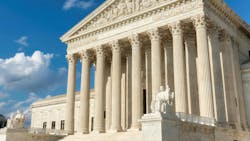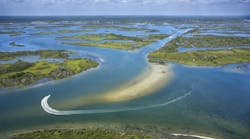The Supreme Court has ruled that two common NPDES permit provisions are invalid: So what's next?
Stormwater managers may welcome the guiding principle of the U.S. Supreme Court's recent decision in City and County of San Francisco v. Environmental Protection Agency: permit holders and applicants should not be responsible for water quality impacts that are beyond their control. The court left much of the framework for regulating stormwater discharges under the Clean Water Act, including standard monitoring and best management practices requirements in place. But importantly, the court ruled that NPDES permits that impose "end-result" requirements, which can impose liability under the Clean Water Act whenever the receiving waters for the discharge exceed water quality standards, exceed EPA's authority under the Clean Water Act.
San Francisco's case highlights the competing concerns that agencies and businesses managing stormwater face. On the one hand, the city and county of San Francisco and its Public Utility Commission have been leaders in environmental advocacy and stewardship in many areas. On the other hand, like many municipalities, the city confronts the challenge of maintaining an aging and arguably antiquated infrastructure — in this case, a combined stormwater and sanitary sewer system that struggles to manage rainfall events. Faced with the possibility of extremely costly upgrades to the system and the rate increases that would be needed to fund the upgrades, the city challenged EPA's authority to impose a broad range of "narrative" conditions commonly found in NPDES permits.
The court rejected the broader version of San Francisco's argument, but agreed with the city that permit conditions based on the exceedance of water quality standards or creating a nuisance in receiving waters were not permitted under the Clean Water Act. The court concluded that such "end-result" or "backward-looking" limitations are inconsistent with the text and legislative history of the Clean Water Act. The court's decision also recognized the unfairness of holding a single discharger liable for water quality exceedances when multiple permittees discharging into a water body could have contributed to the exceedances.
While the court's decision formally addresses San Francisco's relatively uncommon combined sewer system, the decision can be applied to a wide range of NPDES permits that are conditioned on receiving waters or other "end-result" limitations, including permits for municipal separate storm sewer systems (MS4s) and construction stormwater permits.
Permittees can proceed with some certainty that they will not be held liable under the federal Clean Water Act for water quality violations in receiving waters themselves, which will in many instances be well beyond an individual permittee's ability to control. At the same time, permit applications and renewals may face additional scrutiny from EPA and state permitting authorities, who could insist on more data and stricter numerical effluent limitations to compensate for the removal of the "backstop" that receiving water limitations have historically provided.
In addition to the federal scheme, permittees should be aware that the Clean Water Act allows the states to impose stricter requirements on pollutant discharges, beyond the minimum standards required by federal law. State agencies will not necessarily be bound by the limitations in the federal water pollution control scheme, which the Supreme Court characterized as focusing on "'direct restrictions on polluters" as opposed to the regulation of water quality standards.
For example, in California, the Porter-Cologne Act — the state's primary water quality regulation statute — requires Regional Water Quality Control Boards to impose waste discharge requirements that "implement any relevant water quality control plans that have been adopted" and take into account beneficial uses of receiving waters and "the water quality objectives reasonably required for that purpose." (Cal. Water Code, § 13263(a).) As state agencies respond to the San Francisco v. EPA decision, many permitting authorities could decide that they may (or even must) take receiving water quality standards into account under state law.
That said, the distinction between a federal and state law standard may be meaningful to landholders required to maintain NPDES permits who are under threat of litigation. Even if receiving waters limitations continue to be enforceable under state law, those permit conditions would no longer be enforceable through a citizen-suit filed under the Clean Water Act.
In addition, unlike the federal Clean Water Act, state water quality laws may require permitting agencies to take cost into account in setting these limitations. (See, e.g., Cal. Water Code, § 13241.)
All of this is to say that the stormwater management community should take a measured approach to the Supreme Court's decision. Best practices would include:
- Reviewing existing permit requirements and implications for an existing or planned stormwater pollution prevention plan (SWPPP) for "end-result" requirements that are likely unenforceable under federal law. (This would include most "receiving waters limitations" conditions in NPDES permits.)
- Determining whether any control measures could be modified in response to the court's decision. In many cases, the answer to this question will be "No," because the end-result permit conditions are a backstop for specific numerical and other "narrative" conditions (e.g., best management practices) that are not directly affected by the court's ruling.
- Reviewing state law and /or consulting with state permitting authorities to determine if receiving waters limitations could continue to be enforced under state water quality statutes, even if they are not permissible under the federal Clean Water Act.
Dischargers seeking to apply for or renew NPDES permit coverage should also consider seeking more information from their permitting authorities regarding whether any new conditions are being considered to account for the lack of federally enforceable receiving waters limitations in newly issued permits. Finally, permittees that receive notices of intent to file Clean Water Act citizen suits should review the allegations in the notice and should determine if the San Francisco v. EPA decision provides additional defenses to liability.
While there is little doubt that the San Francisco v. EPA decision is a significant change in the law, there will inevitably be a period of transition and uncertainty as regulated entities, permitting authorities, and courts apply the broad principles that the Supreme Court announced to the messy business of managing stormwater discharges from thousands of properties and stormwater sewer systems across the country. Practitioners and permittees should continue to monitor regulatory developments in response to the case.
About the Author
Dana Dean
Dana Dean is a counsel at Hanson Bridgett.
Christopher D. Jensen
Christopher D. Jensen is a partner at Hanson Bridgett.



